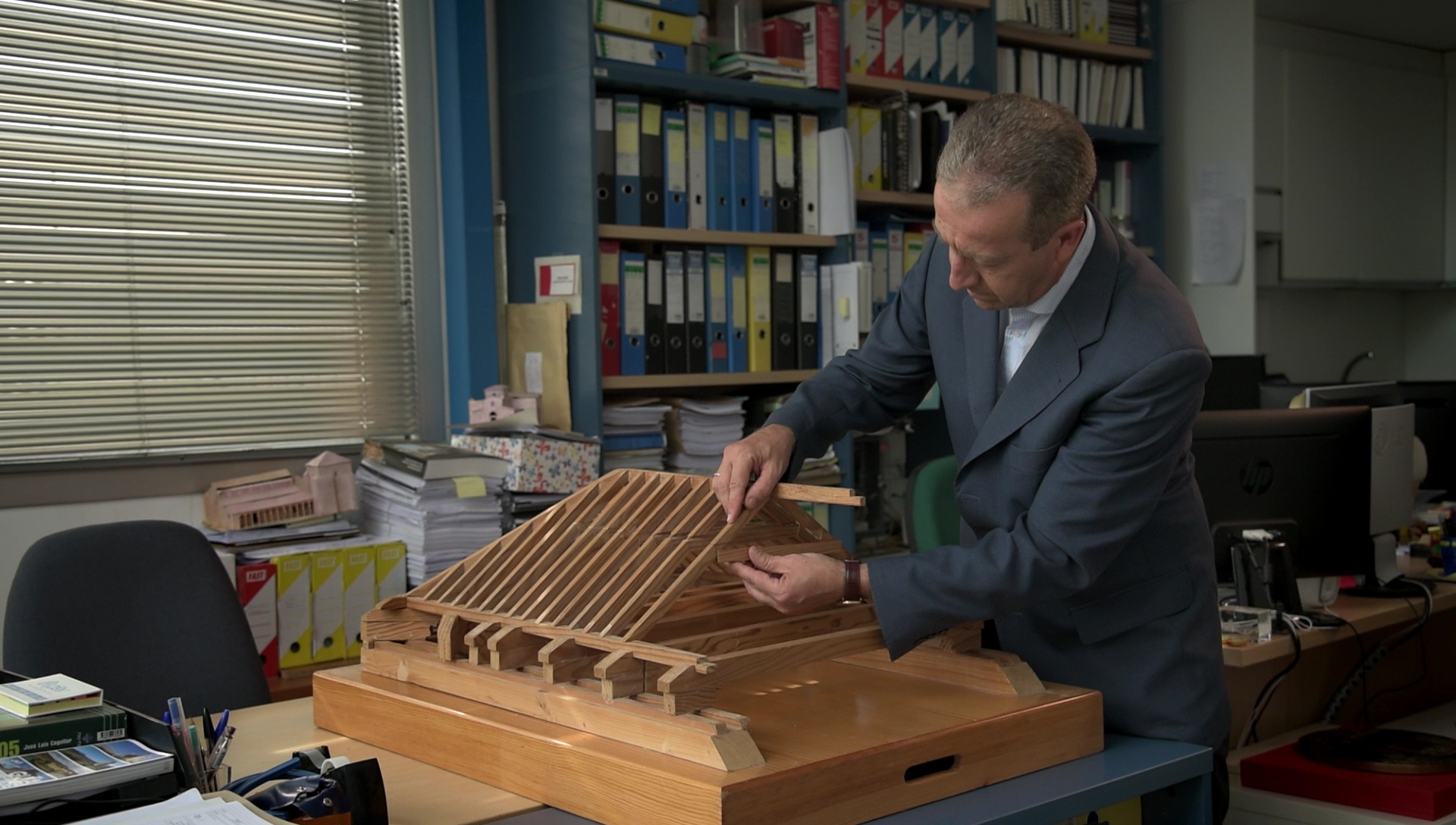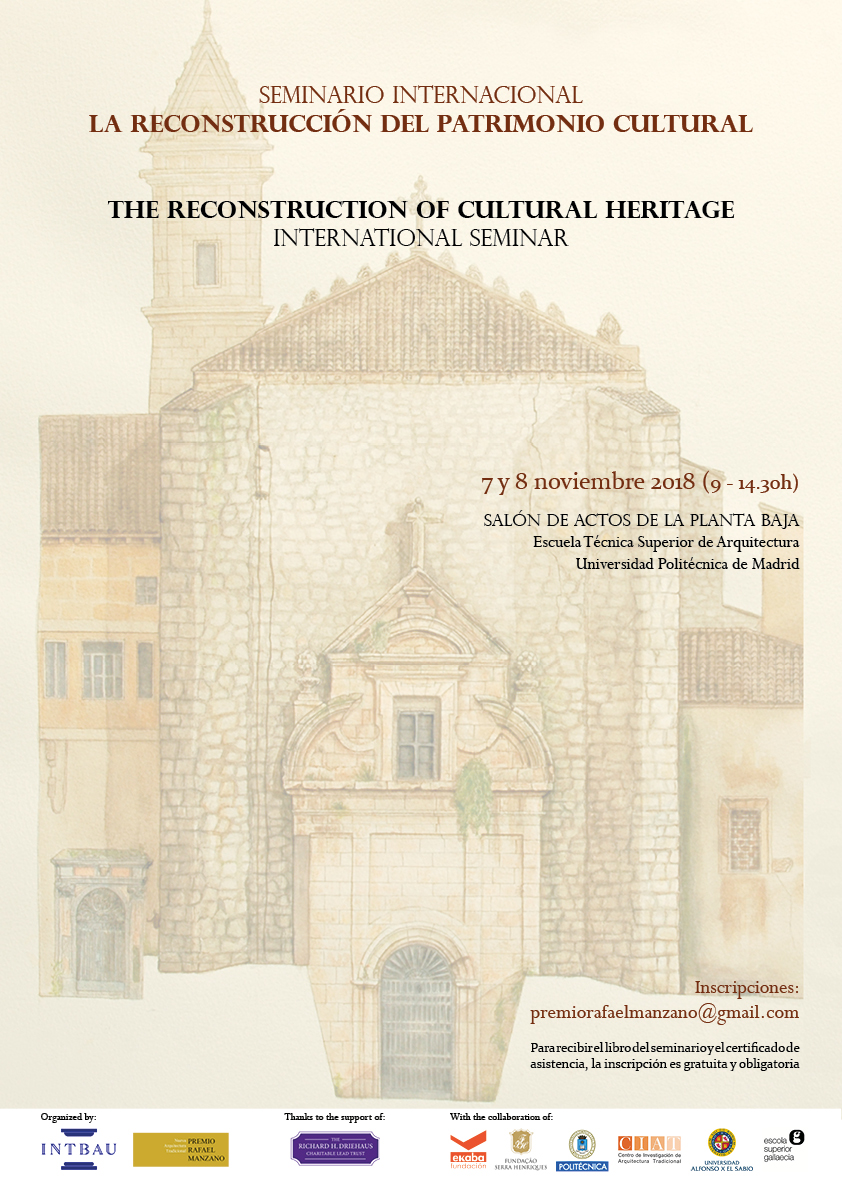Rafael Manzano Prize 2018
JUAN DE DIOS DE LA HOZ
The architect Juan de Dios de la Hoz has been awarded the Rafael Manzano Prize for New Traditional Architecture 2018 for his mastery of the traditional and historical forms and techniques, which he has exhibited in many of his interventions related to historical heritage. Especially significant are the various monuments which, having been found in a state of complete ruin, have required important works on his behalf to reconstruct them. Among these works we should highlight the ones carried out in Lorca, reconstructing the rundown or damaged main buildings within the city which were left in this state due to an earthquake which affected the area in 2011.
VIDEO PRESENTING JUAN DE DIOS DE LA HOZ AND HIS WORK
Video made by Beatriz Pérez-Porro presenting the work of Juan de Dios de la Hoz, for which he has been awarded the Rafael Manzano Prize 2018.
Biography
Born in Madrid in 1963, he graduated from the School of Architecture in Madrid in 1988; he has a Masters in Heritage Restoration and Rehabilitation from both the University of Valladolid and the University of Alcalá de Henares dating 1996. He has been a professor at the School of Architecture at the Camilo José Cela University in Madrid, teaching from 2003 to 2013 in the area of Restoration and Rehabilitation. He has also been a lecturer at various congresses, seminars, and sessions related to heritage and restoration at different Spanish and foreign universities, as well as a lecturer in courses related to traditional building materials and techniques and their use in the restoration of monuments.
He set up his architecture office in 1998, Lavila Arquitectos, dedicated to architectural heritage restoration with a growing international projection. His works include: the Cathedral and the Bishop’s Palace in Alcalá de Henares; the Castle in Belmonte; the Cathedral in Cartagena; the Bishop’s Palace in Murcia; the church and the crypt of the ducal pantheon within the San Francisco Monastery in Guadalajara; the Monastery in Yuste; and the monumental complex of the former Convent of La Coria, located in Trujillo.
He is currently carrying out works at the church and Santiago y Monserrat Episcopal College in Rome; the restoration of the former Royal Textile Factory in Brihuega; and the restoration of the Monastery of Santa Maria de Bonaval. He also works as an advisor to the project management team leading the works of the Cathedral in Panama.
The Reconstruction of the Architectural Heritage
In addition, among the works relating to the reconstruction of buildings in a state of ruin, the ones concerning the Castle in Brihuega must be mentioned. Among the diverse restoration works, one of the most important is the resurrection of the palace’s main rooms. The noble room located on the northwestern part of the castle, of which only some of its original walls remain, has come back to life and can once again be used thanks to this project, which has involved rebuilding its walls; restoring its primitive door from the pieces and documentations which had been preserved; retracing its diaphragm arches following the existent traces; and completely reconstructing the ligneous structure of the roof which once again rests on top of them.
Other works of great significance are those developed in Lorca after the devastating effects of the aforementioned catastrophe: the Churches of San Patricio, San José, San Mateo, Santiago, Nuestra Señora del Carmen and the Convent of San Francisco, works for which he was awarded the Europa Nostra 2016 Award. In many of these cases, it was interventions prior to these, generally with reinforced concrete, that greatly caused the devastation. Even with the use of these contemporary methods, the aim was to reinforce these monuments, which have once again proved to be incompatible with historical construction, due to their high rigidity and their monolithic-like functions. This sort of intervention requires the knowledge of the original techniques for their adequate maintenance–knowledge Juan de Dios has. The most extreme case of this type of ‘reparations gone wrong’ was found at the churches of Santiago and San José.
In the church of Santiago, the reinforced concrete bracing, introduced in the structure to cover the crossing, caused it to collapse completely and also resulted in the destruction of all the chapels located around it. Juan de Dios’ intervention was based on recovering the compatibility between the old and the contemporary elements. For that purpose, four large centerings were built to enable the placement of the four main arches which bear the weight of the dome. These arches, covering a span of ten metres, were built out of brick with the exact same dimension they originally had and with the same characteristics with which they were built. Once these arches were erected, the four pendentives were built using brick as well, and after all this, the drum of the dome was rebuilt. This drum supports two structures, both of which are made of wood: one which can be seen from the inside of the temple and one which bears the weight of the roofing, which protects it and which can be seen from the outside. Making them out of wood was crucial, as well as the need for both of them to be independent and placed on top of different plates, being able to move independently as well. They had to be light and compatible with the material they had underneath, contrary to what happened with the previous intervention. Thanks to this decision, the problems which occurred and had caused the collapse of the previous dome will not reoccur.
In the church of San José, the structure which covers the temple is made out of a very common sort of vault within the Hispanic tradition, bóvedas encamonadas. It is a structure which completely adapts to the need for covering large spans with wooden elements of reduced dimensions, which at the same time bear the weight of the reed boards (camones) which, once they have been given a plaster covering, create the spatial effect of any other common vaulted structure. They are made of wooden structures made at the same time out of a large number of small elements, and it makes them an optimal solution to resist the impact of an earthquake. However, once again, the effect this earthquake had added up to the prior inadequate interventions giving way to important damages of the building. In the new restoration project, Juan de Dios has maintained a few elements which were still in a salvageable state, replacing only those which really needed to be replaced by other identical ones both in terms of functioning and shape.
Lastly, the most relevant aspect of these works in Lorca was through retrieving the symbolic value that this heritage has for the city itself. The structure of its city centre was returned to the community who had suffered because of the loss of some of its main architectural landmarks.
Original Text in English with Additional Photos
Texto Original en Español con Fotos Addicionales
The Reconstruction of Cultural Heritage International Seminar
7-8 NOVEMBER 2018 | SALÓN DE ACTOS (GROUND FLOOR) OF THE SCHOOL OF ARCHITECTURE IN MADRID (ETSAM)
The International Seminar which is organized annually by INTBAU and the Rafael Manzano Prize will be held at the School of Architecture of the Universidad Politécnica de Madrid (ETSAM) on November 7 and 8, 2018.
It has been organized by INTBAU and the Rafael Manzano Prize for New Traditional Architecture, thanks to the support of the Richard H. Driehaus Charitable Lead Trust, through a grant from the Chicago Community Foundation for the Richard H. Driehaus Charitable Fund, and the collaboration of the EKABA Foundation, the Fundação Serra Henriques, Universidad Politécnica de Madrid, the Escola Superior Gallaecia, the Universidad Alfonso X el Sabio, and the Centro de Investigación de Arquitectura Tradicional (CIAT-UPM), and it celebrates the European Year of Cultural Heritage.
The lectures will be indistinctly in Spanish or English, but we will have simultaneous translation Spanish-English and English-Spanish for all of them.
The registration is COMPULSORY and FREE for all those who wish to receive the program and book of the seminar, as well as the attendance certificate, and can be done by filling in the form at the end of this page or by writing an email to the address:
premiorafaelmanzano@gmail.com
Text courtesy of Premio Rafael Manzano, Rebeca Gómez-Gordo Villa, and Alejandro García Hermdia

